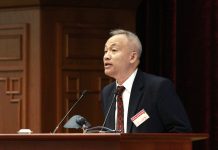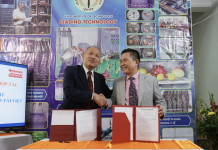Plasma gasification is in commercial use as a Waste-to-Energy system that converts municipal solid waste (MSW), tires, hazardous waste, and sewage sludge into synthesis gas (syngas) containing hydrogen and carbon monoxide that can be used to generate power. Municipal-scale waste disposal plasma arc facilities have been in operation in Japan and China since 2002. No commercial implementations in Europe and North America have succeeded so far. The technology is characterized by the potential of very high level of destruction of the incoming waste, but low or negative net energy production and high operational costs. Plasma gasification is used commercially for waste disposal at five locations worldwide representing a design capacity of 200 tonnes of waste per day in total, of which 100 tonnes per day is biomass waste.
Existing facilities
National Cheng Kung University – Tainan City, Taiwan (PEAT International)
PEAT International constructed a plasma arc waste disposal facility at National Cheng Kung University (NCKU) in Tainan City, Taiwan, which uses its proprietary Plasma Thermal Destruction Recovery method. The facility is able to handle 3–5 metric tons (3.3–5.5 short tons) of waste per day from a variety of waste streams, including incinerator fly ash, medical waste, organic industrial process waste and inorganic sludges. It can also process waste consumer batteries and other materials, including heavy metal sludges, and refinery catalysts (waste streams that would generate valuable metal alloys). The facility was constructed as part of a comprehensive resource recovery facility funded by the Taiwanese government, marking the first time the Government of Taiwan committed financial and technical resources to the utilization of plasma technology. It was commissioned in November 2004 and received its operating permit in January, 2005. PEAT has been an active participant in the operations and maintenance of the facility on behalf of NCKU for its research purposes.
Mihama-Mikata, Japan (Hitachi Metals Ltd.)
In 1999 a 166-short-ton (151 t) per day “pilot” plant was built in Yoshii, co-developed by Hitachi Metals Ltd. and Westinghouse Plasma. It was certified after a demonstration period in 1999–2000. The Yoshii pilot plant was decommissioned when the pilot program ended in 2004.
A 165-short-ton (150 t) per day plant was completed in 2002 in Utashinai City. It took over 5 years to start it up due to problems with size of the bottom of the reactor, carryover of sticky particulate, and the wrong choice of refractory. As a result, it lost its waste supply contracts and did not meet its design heat and material balance, so Hitachi Metals shut it down in 2013. In 2002 a 28-short-ton (25 t) per day plant was commissioned in the twin cities of Mihama and Mikata. The Westinghouse Plasma plants used a fixed bed gasifier with plasma torches in the bottom, with addition of coke to add energy and act as a bed for slag, and addition of lime or similar fluxing agent.
USS Gerald R. Ford (CVN 78) Supercarrier – US Navy (PyroGenesis Canada Inc.)
In 2008, Northrop Grumman Newport News (now known as Huntington Ingalls – Newport News Shipbuilding), issued a contract to PyroGenesis Canada Inc. for the supply of a Plasma Arc Waste Destruction System (PAWDS) to be installed on board the Navy’s next generation aircraft carrier. The compact system was installed and designed to treat 200 kg/h combustible solid waste without energy recovery on the ship, which was christened in November 2013.
Pune, Maharashtra, India (Maharashtra Enviro Power Limited)
SMS Infrastructures Limited (SMSIL), Central India’s largest civil engineering and infrastructure development company, constructed a 72 tonne-per-day hazardous waste-to-energy plant, located in Pune, India. It was commissioned in 2008 and use Westinghouse Plasma Corporation’s (WPC) plasma technology and reactor vessel design. It processes hazardous waste. The produced gas is immediately combusted in a steam boiler feeding a stream turbine producing up to 1.6 MW (net) of electricity. The facility is the largest plasma gasification WTE plant in the world processing hazardous waste.
Wuhan, China (Wuhan Kaidi/Alter NRG, demonstration plant)
In January 2013, Alter NRG announced that Wuhan Kaidi had successfully commissioned a Westinghouse plasma gasification unit at a demonstration facility located in Wuhan, China. The plasma gasification unit was designed to process approximately 100 tons per day of biomass waste and convert it to clean syngas. The clean syngas is then to be converted into diesel fuel and other transportation fuels at the Kaidi facility.
Planned facilities
Swindon, Wiltshire, England, UK, (Advanced Plasma Power)
In 2015 Advanced Plasma Power has been awarded 11 million GBP of funding from the Department of Transport and 6 million GBP from Ofgem to develop and erect the first commercial gasification facility based on the Gasplasma process. The process consists of gasification, plasma gas treatment, syngas polishing and gas engine power generation. It will be designed to produce gas for powering vehicles, power, heat and aggregate glass from processing 7500 tonnes of refuse-derived fuel annually. Construction is expected to start during 2016. The installation will be used by Advanced Plasma Power for testing and development purposes rather than as a commercially operated plant.
Hirwaun, Wales, UK (EnviroParks Limited)
EnviroParks Limited plan (31/9/07) a consortium to build an Organic Park in Tower Colliery at Hirwaun, South Wales. This includes a plasma gasification plant combined with advanced anaerobic digestion to divert municipal solid waste from the landfill. Enviroparks are currently collaborating with partner Europlasma of Bordeaux to provide the plasma gasification unit to the park.
As much as £60 million is being put into the project by EnviroParks Ltd and its partners, to establish organic waste and mixed waste treatment facilities next to the Tower Colliery at Hirwaun. The Hirwaun site itself is large enough for the processing of over 250,000 metric tons (280,000 short tons) of non-hazardous waste a year. Initially, though, an anaerobic digestion plant will be designed to handle 50,000 metric tons (55,000 short tons) of organic wastes a year. According to the web site, as of early 2013 “…we hope to be receiving waste on the 20 acre site by 2014.”. As of November 2016 the delayed gasification plant were still in the design phase according to EnviroParks.
Mothballed Projects
Tees Valley Renewable Energy Center (Air Products/AlterNRG)
A 49 MW power plant using plasma gasification was abandoned by the owner during the commissioning phase at Teesside in the UK. Fully permitted, work on the site began in 2013. Work continued on the first phase using AlterNRG gasifier, and construction of an identical phase began before the first phase was completed. Each plant used the “world’s largest gasifier” to date, but neither was able to run, as the technology had not been proven at scale. Commissioning on the first phase was started in late 2014. By late 2015, Air Products halted construction on the second phase until it fixed the issues. On April 4, 2016, Air Products announced it was leaving the waste-to-energy business, and was taking a write-down of $0.9-$1.0B
Hurlburt Field, Florida, USA (PyroGenesis Canada Inc.)
On April 26, 2011, the Air Force Special Operations Command (AFSOC) inarguated its Transportable Plasma Waste to Energy System (TPWES) facility, located at Hurlburt Field, near Fort Walton Beach Florida, USA. The facility was designed, constructed and commissioned by Montreal-based PyroGenesis Canada Inc., and the unit deployed at the facility was based on the company’s Plasma Resource Recovery System (PRRS) technology. The plant was designed to process 10.5 metric tons per day of municipal solid waste, as well as hazardous and biomedical waste. The syngas generated by the process was fed to an internal combustion engine to produce electricity, while the inorganic fraction of the waste feed was converted into an inert, vitrified slag which could allegedly be used for building materials. The system was designed to be energy neutral and transportable.
The plant, which cost $7.4 million to construct, was closed and sold at a government liquidation auction in May 2013. The opening bid was $25. The winning bid was sealed.
East Luther / Grand Valley, Ontario, Canada (Navitus Plasma Inc)
Navitus Plasma Inc. proposed the installation of a system named “DEEP” “Dufferin Eco Energy Park” within East Luther Grand Valley located in the County of Dufferin (approximately 45 minutes north of Toronto) and planned to take all municipal garbage for the county to this facility. In 2014 project DEEP was reported to be likely to be shelved. As of April 2016 no more recent traces of project DEEP was found on the public internet.
St. Lucie County, Florida, USA (GeoPlasma)
The first plasma-based waste disposal system in the USA was announced in 2006 in St. Lucie County, Florida. The county stated that it hopes to not only avoid further landfill, but completely empty its existing landfill — 4,300,000 short tons (3,900,000 t) of waste collected since 1978 — within 18 years. The plant was originally scheduled to come into operation in 2009, but experienced several setbacks. Backers originally announced that the facility would produce 600 short tons (540,000 kg) of solid rubble from around 3,000 short tons (2,700,000 kg) of waste per day at 5,500 °C (9,900 °F), but uncertainties arose regarding the safety of such a facility. The public health and environmental threats from incinerators coupled with the uncertainty of the community’s ability to produce such large quantities of waste on a consistent basis have led GeoPlasma to submit a new proposal for a much smaller facility that would convert 200 short tons (180 t) of waste per day. Plans were to begin building the $120 million facility in 2011. In April 2012, St. Lucie officials announced that they had terminated the contract with GeoPlasma thereby ending the project.
Tallahassee, Florida, USA (Green Power Systems)
The city of Tallahassee, Florida has signed the largest plasma arc waste to energy contract (35 MW) to date with Green Power Systems to process 1,000 short tons (910 t) daily from the city and several surrounding counties. Completion of the project was scheduled for October 2010, but canceled in 2008.
Vancouver, British Columbia, Canada (Plasco Energy Group Inc.)
A proposed Plasma arc gasifier has been planned for the Metro Vancouver area. However residents of the area have protested. Metro Vancouver is currently conducting an RFP process to determine a long-term solution for waste management. Plasco is not proposing that Metro Vancouver discontinue the RFP process, but rather to establish an interim solution that can quickly address the shortfall in landfill capacity, while also providing a facility that will allow Metro Vancouver to closely scrutinize and evaluate this new technology as part of its long-term decision making process. In 2008, the EPC Task Force recommended against the project.
Port Hope, Ontario, Canada (Sunbay Energy Corporation)
Utilizing technology licensed from Europlasma, the plasma arc facility proposed for lands in the vicinity of Wesleyville in Port Hope, Ontario (approximately 45 minutes east of Toronto) will handle 400 short tons (360 t) per day of Municipal Solid Waste (MSW) and Tire Derived Fuel (TDF). Sunbay Energy is currently obtaining the required approvals from Provincial authorities and intends to have the facility operational during the 4th Quarter of 2009. This project appears to have subsequently chosen an approach other than plasma gasification.
Jackson, Georgia, USA (PR Power Company)
PR Power Co. plans to open a plant south of Atlanta, near Jackson, Georgia, that will use a “plasma torch” to vaporize tires down to their natural elements — mainly hydrocarbons and scrap steel. The gases will be converted to electricity for sale to electric utilities and the scrap steel will be sold at an estimated $50 a ton.
Red Deer, Alberta, Canada (Plasco Energy Group Inc.)
Plasco was preparing to start construction on a commercial-scale facility in Red Deer, Alberta in the Summer of 2009. This facility, which was to be the company’s first commercial plant, was expected to be completed by the end of 2010, however in February 2012 it was announced that because the city would only give the plant 10% of its garbage Plasco pulled out of the project, effectively killing it. Red Deer MP and supporter of the Plasco project, Bob Mills (Conservative Party of Canada), criticized the city saying “and so, the project died due to a lack of garbage.
Energy Park Peterborough, England, UK (Tetronics)
Energy Park Peterborough – the UK’s First Green Energy Park, which was to be managed by Peterborough Renewable Energy was granted consent by the Government Department for Energy and Climate Change (DECC) in November 2009. It should take in mixed waste and – through a combination of recycling, gasification and plasma-enhanced waste recovery – recycle and remanufacture it, producing reusable products and renewable energy in the process. Tetronics was to supply the Plasma Hazardous Waste Treatment Technology. The technology should have turned the Air Pollution Control (APC) residue generated from the Biomass Power Plant into bricks and tiles for the building industry, thereby; ensuring close to zero residues to be landfilled. Construction was scheduled to begin in 2012.[43] The Energy Parks plans in Peterborough were scrapped in November 2015.














